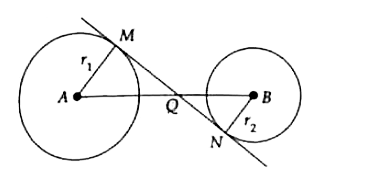No. of Direct and Transverse Common Tangents When |C1C2|=r1+r2
To determine the number of direct and transverse common tangents when the distance between the centers of two circles |C1C2| is equal to the sum of their radii r1+r2, we can follow these steps:
1. Understanding the Condition:
We are given that the distance between the centers of the circles |C1C2| is equal to the sum of their radii r1+r2. This means the two circles are externally tangent to each other.
2. Direct Common Tangents:
- When two circles are externally tangent, there are always two direct common tangents.
- These tangents do not intersect the line segment joining the centers of the circles and touch each circle at one point each.
- Therefore, for our case, we conclude that there are 2 direct common tangents.
3. Transverse Common Tangents:
- For transverse common tangents, we consider the tangents that intersect the line segment joining the centers of the circles.
- When the circles are externally tangent, there is only 1 transverse common tangent.
- This tangent touches both circles at the point where they are tangent to each other.
4. Final Count:
- Thus, when |C1C2|=r1+r2, we have:
- Number of Direct Common Tangents: 2
- Number of Transverse Common Tangents: 1
Summary:
- Direct Common Tangents: 2
- Transverse Common Tangents: 1
We are given that the distance between the centers of the circles |C1C2| is equal to the sum of their radii r1+r2. This means the two circles are externally tangent to each other.
- When two circles are externally tangent, there are always two direct common tangents.
- These tangents do not intersect the line segment joining the centers of the circles and touch each circle at one point each.
- Therefore, for our case, we conclude that there are 2 direct common tangents.
- For transverse common tangents, we consider the tangents that intersect the line segment joining the centers of the circles.
- When the circles are externally tangent, there is only 1 transverse common tangent.
- This tangent touches both circles at the point where they are tangent to each other.
- Thus, when |C1C2|=r1+r2, we have:
- Number of Direct Common Tangents: 2
- Number of Transverse Common Tangents: 1
- Direct Common Tangents: 2
- Transverse Common Tangents: 1
Similar Questions
Knowledge Check
There are two circles C1 and C2 whose radii are r1,r2, respectively. If distance between their centre is 3r1−r2 and length of direct common tangent is twice of the length of transverse common tangent. Then r1:r2 is:
A5:4B6:5C7:6D8:7Instruction : Answer the questions given below on the basis following figure.

MN is a transverse common tangent. A and B are centres of the circles whose radii are respectively r1andr2. Length of AB is d.
Length of MN isA√d2−(r1+r2)2B√d2−(r1−r2)2C√d2+(r1+r2)2D√d2+(r1+r2)2
No. of Direct and Transverse Common Tangents When |C1C2|>r1+r2
View SolutionNo. of Direct and Transverse Common Tangents When |C1C2|<|r1−r2|
View SolutionNo. of Direct and Transverse Common Tangents When |r1−r2|<|C1C2|<r1+r2
View SolutionLength of Direct and transverse common tangent
View SolutionCommon Tangents of Two Circles - Direct and Transverse Common Tangent
View SolutionThe line L1≡3x−4y+1=0 touches the circles C1andC2. Centers of C1 and C2 are A1(1,2) and A2(3,1) respectively Then, the length (in units) of the transverse common tangent of C1andC2 is equal to
View Solution
